Driveline
Balancing efficiency and durability
20 May 2025
11 January 2017
Assessing the potential for specialised transmission fluids
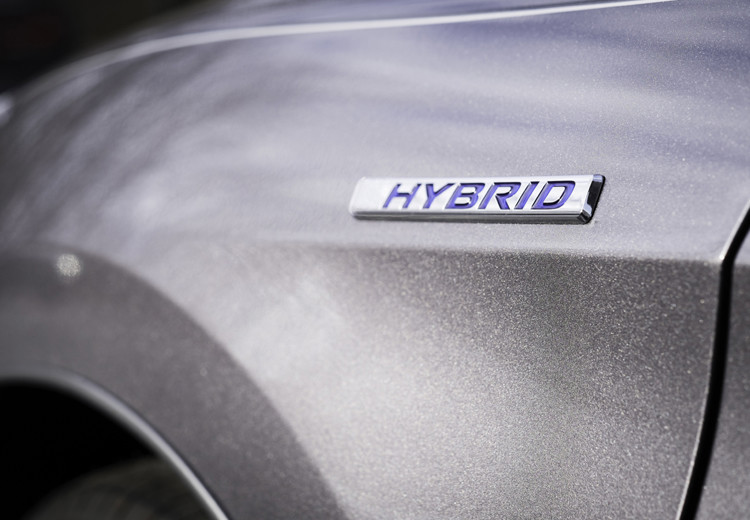
As legislation to curb CO2 emissions is introduced or tightened across the globe, OEMs are employing advanced technologies, including hybrid systems, to help them meet fleet-wide targets. Callum Sugden, Infineum PTF Development Chemist, explores the trends in hybrid transmissions and the potential requirement for advanced transmission fluids.
Hybrids, which typically combine both electric and conventional internal combustion engine (ICE) propulsion systems, are being used by OEMs to help meet the latest fuel economy and CO2 emissions targets in addition to gaining additional incentives offered by current legislation. These benefits are achieved by having an electric motor to assist the ICE and utilising efficiency-improving technologies, such as brake energy regeneration.
The term ‘hybrid’ covers a number of different types of system – all of which are available in the market today.
Within these hybrid types there are five different architectures: parallel, series, power split, through the road and complex, each with a number of associated advantages and disadvantages.
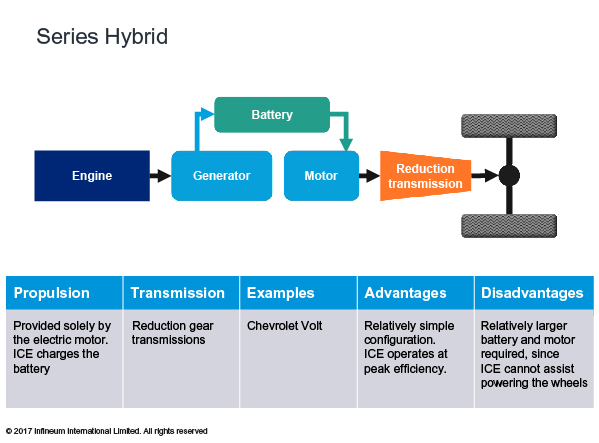 Series hybrids are efficient and relatively simple, but power sources cannot be combined
Series hybrids are efficient and relatively simple, but power sources cannot be combined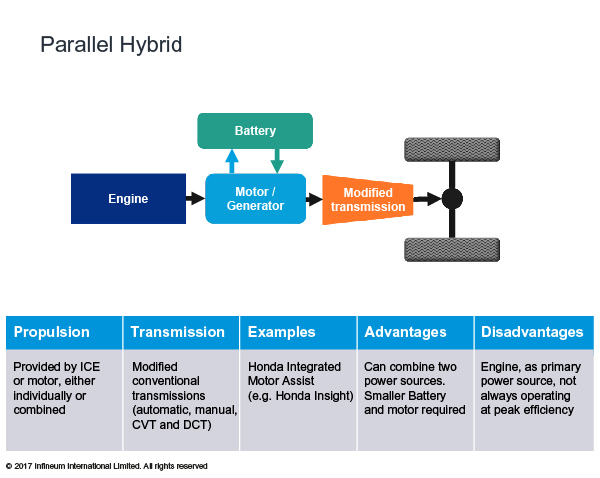
Parallel hybrids can combine two power sources although the battery cannot be charged and electric motor used to provide power simultaneously
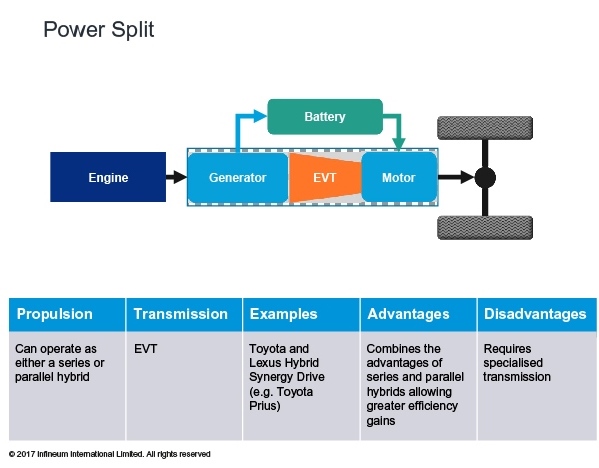 Power split hybrids combine the advantages of series and parallel hybrids
Power split hybrids combine the advantages of series and parallel hybrids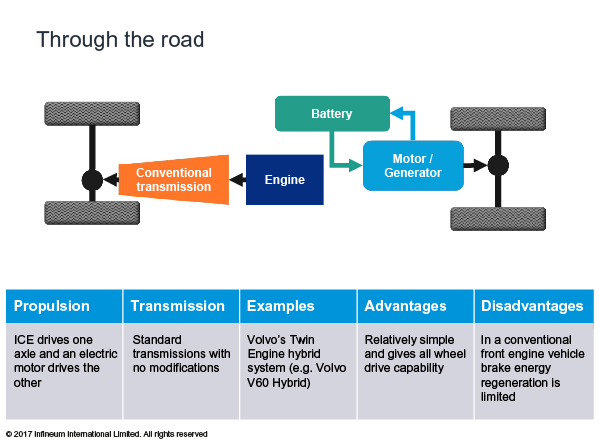 Through the road hybrids are relatively simple and give all wheel drive capability
Through the road hybrids are relatively simple and give all wheel drive capability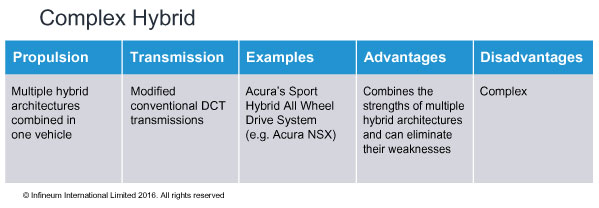 Complex hybrids combine the strengths of multiple hybrid architectures
Complex hybrids combine the strengths of multiple hybrid architecturesIn 2015 Japan had the largest volume of hybrid sales, where they accounted for 19% of new vehicle sales. In North America, while half a million hybrid units were sold in 2015, this only represented 2.6% of new vehicle sales. In Europe, where diesel cars are popular, and in China there is only limited interest in hybrid technology, with 1% of 2015 new vehicle sales being hybrids.
Growth in the hybrid vehicle market is forecast, which should, in turn, drive significant growth in the production of hybrid transmissions.
Industry forecasters expect Toyota to remain the market leader for the foreseeable future, the market is diversifying, and all the major players are likely to increase hybrid transmission production in the coming years.
In this growing market, the questions of real interest to fluid marketers are what transmissions and fluids are being used in the most widely used power split and parallel hybrid architectures and do they require dedicated fluids?
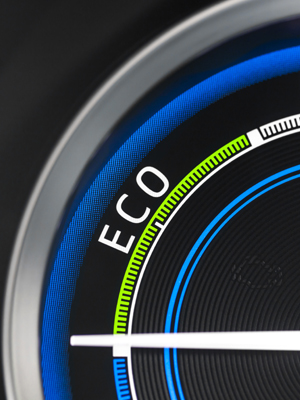 Growth in the hybrid vehicle market is forecast
Growth in the hybrid vehicle market is forecast Power split hybrids exclusively use an electric variable transmission (EVT). This transmission, pioneered by Toyota, incorporates the power split device that allows the vehicle to operate either as a series or parallel hybrid. From the driver's seat it can feel as though the vehicle has a continuously variable transmission (CVT), but the hardware is quite different, using a planetary gear set. Currently Toyota / Lexus hybrids and some models from Ford, Honda & GM come with an EVT transmission, which use conventional automatic transmission fluids (ATF) including Toyota WS, Ford LV, Honda ATF DW-1 and DEXRON® VI.
Parallel hybrids are offered with a range of transmission types – CVT, stepped automatic (AT), dual clutch (DCT) and manual. CVTs are currently the most popular, primarily used by Honda and Jatco. However, Honda is phasing out CVT in favour of EVT and DCT, leaving Jatco as the major player in hybrid CVT going forward. Conventional CVT fluids, Nissan NS-3, Honda CVTF, are typically used in these transmissions.
Stepped AT hybrids are already employed by a number of OEMs. To date, Hyundai has produced the most units, which are used in the Sonata & Kia Optima Hybrids. Daimler and ZF use similar modular hybrid systems that consist of an electric motor with a wet clutch that is integrated into the transmission in place of the torque converter. As Daimler and ZF invest more in hybrids, we expect these transmissions to become more prevalent. Conventional ATFs Diamond SP-IV, DEXRON® VI, MB 236.15, ZF S671 090 312, are used in these transmissions.
DCT hybrids are currently used by Honda and Volkswagen, with both OEMs offering low torque dry clutch and high torque wet clutch hybrid transmissions. Growth in hybrid DCTs can be expected as Volkswagen and other OEMs invest in hybrid technology. Hyundai, for example, has launched a dry clutch DCT hybrid in their Ioniq / Kia Niro and Daimler and ZF is also likely to launch hybrid DCTs in future. Currently VW uses G 052 182 (wet clutch) and G 052 512 (dry clutch), Honda uses ATF, DW-1 (both wet and dry clutch).
Honda is the only OEM with a manual hybrid in its line up, which was offered in the original Insight and CRZ using a conventional Honda MTF-3. However, manual hybrids are now being phased out, which means this type of transmission is expected to remain a very niche market.
The use of current fluid technology in all these systems suggests the fluid performance requirements are broadly similar to those delivered by conventional transmission fluids. However, it is important to understand whether the transmission fluid comes into contact with the electric motor.
In the power split hybrid with EVT, by far the most common today, where the electric motor is integrated into the transmission, the fluid does make contact. In a parallel hybrid with CVT, stepped AT, DCT or manual transmission the fluid can also come into contact with the electric motor, although this is dependent on where it sits in the drivetrain. But, with most current parallel hybrid configurations the electric motor is integrated into the transmission, which means it also makes contact with the transmission fluid.
Current hybrid transmissions on the market do not use dedicated hybrid transmission fluids. This is likely to be because, for most OEMs, hybrid transmissions are not yet produced in sufficient volumes, which means the cost of developing and commercialising a dedicated hybrid fluid cannot be justified.
In our view, the requirement for dedicated hybrid transmission fluids will increase as production volumes rise.
Infineum is exploring which technological solutions enable optimal hybrid performance in all available architectures.
Sign up to receive monthly updates via email